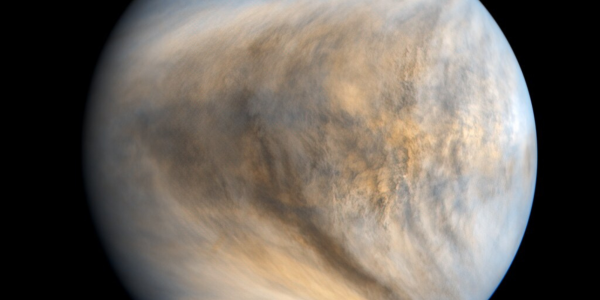New experiments in a simulated Venusian atmosphere shine light on a long-standing mystery.
From early, grainy pictures of Venus to the high-resolution images of today, one mystery has remained: Why is our closest neighbor so stripey? When the planet is viewed through UV telescopes, dark C-shaped or Y-shaped streaks mark the upper clouds, raising questions about the chemical processes that shape the atmosphere of our nearest planetary neighbor.
“We’ve known for a long time that the dense Venusian atmosphere is carbon dioxide and nitrogen, with thick sulfuric acid clouds,” said Alian Wang, a research professor of Earth, environmental, and planetary sciences and the leader of the Planetary Spectroscopy Research Group. “Those clouds reflect sunlight very strongly, which is why Venus looks so bright. So why do UV telescopes show so many dark streaks?”
To address this century-long mystery, researchers at WashU ran experiments in a chamber designed to simulate the temperature, pressure, and basic compounds of the upper levels of the Venusian atmosphere, including nitrogen, carbon dioxide, and sulfur dioxide. To fully recreate Venus’s cloud layer, the team sent an electric charge through the gaseous chamber, an Earth-bound simulation of Venusian lightning.
Wang and colleagues wanted to know if their Venus-like simulation could produce compounds that absorb UV light at the same wavelengths as the planet’s dark streaks. Pinpointing the source of the compounds — referred to as “unknown UV absorbers” — could help unlock the mysteries of Venus’s streaky skies.
The experiment was described in Earth and Planetary Science Letters. Co-authors include Hongkun “Quincy” Qu, PhD ’24, Wang’s former PhD student who is now a postdoctoral researcher at Shandong University in China; Elijah Thimsen, an associate professor of energy, environmental, and chemical engineering in McKelvey; and WashU alum Zongchen Ling, PhD ’08, now the leader of Planetary Science at Shandong University.

(Credit: NASA)
Using a plasma spectroscope to track the compounds swirling in the chamber, Wang and colleagues found that lightning-like electric pulses supercharged the breakdown of sulfur dioxide. “Our mid-strength electrical discharge is about 1,000 times more effective than the sunlight on Venus at breaking down sulfur dioxide,” Wang said.
The reaction created many types of sulfurous free radicals, including two highly reactive compounds, SO* and S2* (the asterisks denote free radicals), that occurred simultaneously. Both radicals could serve as precursors for UV-absorbing compounds, such as sulfur oxides, sulfuric acid, polysulfur, or cyclooctosulfur, a ring-shaped molecule made of eight sulfur atoms.
“A lightning bolt on Venus could set off a tsunami-like wave of these compounds across the atmosphere, moving at speeds of 100 meters per second,” Wang said. Their findings suggest that two types of free radicals are equally likely to be produced by lightning, implying that both contribute to the production of the UV-absorbing compounds and, ultimately, Venus’s dark streaks.
The Venus simulator, built by Qu, allows WashU scientists to study Earth’s sister planet without leaving campus. “A Venus chamber acts as a laboratory for studying extreme climate change, planetary evolution, and even astrobiology,” Qu said. “Deciphering its chemistry helps us understand not just Venus, but the fate of Earth-like worlds, making it a top priority in planetary science.”
“This paper is sure to make an impact,” said Kevin Olsen, a UK Space Agency Fellow at the University of Oxford who was not involved in the current study. “It has shown a mechanism in the upper atmosphere that can efficiently create the new sulfur species that could fill in for the famous unknown UV absorber. This reveals a path forward for reanalyzing Venus mission data and for more experimental and modeling investigations.”
Header image credit: JAXA/ISAS/DARTS/Kevin M. Gill





